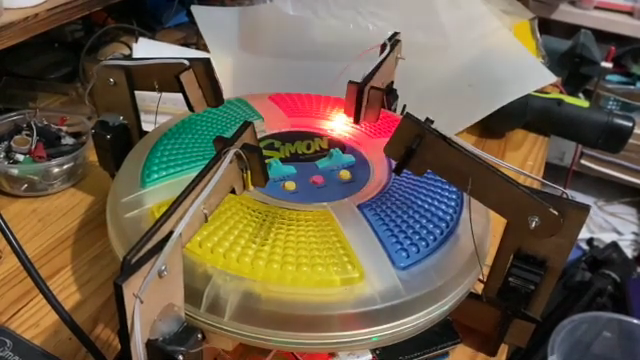Remember Simon? We sure do. Simon — as in “Simon says…” — from the leading edge of electronic games in the 1970s, which used four buttons, colored lights, and simple tones as the basis for a memory game. Players had to remember the specific sequence of lights and replay the pattern in order to advance to the next round. It was surprisingly addictive, at least for the era.
For those who never quite got into the Simon groove, fear not — the classic game has now been fully automated. While there were plenty of approaches that could have taken to interfacing to the game, [ido roseman] went with the obvious — and best, in our opinion — technique and simulated a human player’s finger presses with servo-controlled arms. Each arm carries a light-dependent resistor that registers the light coming from the key it’s poised above; the sequence of lights is sensed and recorded by an Arduino, which then drives the servo fingers’ replay attack. The fingers aren’t exactly snappy in their response, which might cause problems — if we recall correctly, Simon is somewhat picky about the speed with which the keys are pressed, at least at higher levels of play.
On the whole, we really like this one, not least for the nostalgia factor. We’ve had a lot of recreations of Simon over the years, including a Dance Dance Revolution version, but few attempts to automate it. And a crazy idea: wouldn’t it be fun to replace the replay attack with a machine learning system that figures out how to play Simon by randomly pressing keys and observing the results?















Cool! Maybe one can skip the servos and go straight to using relays or maybe even some small transistors to close the switches and put the Simon’s processor to work. I’ll wait for him to take bop-it next. Hate that antagonizing game.
I did it for 2 reasons: first I did not want to open and change the game itself. but the main reason, it seems more fun. the game logic by itself is not much of a challenge. building the “automated player” and making it interactive is much more pleasing to the eye. you may look at it as an art installment.
What’s the longest sequence the game does?
it depends on the difficulty level : 8, 14, 20 and 31.
Why doesn’t he move the “fingers” closer to the buttons? Less servo action would be required, and it could be faster.
this is still a work in progress, much to be improved
Sorry, that was meant to be a friendly suggestion, but I typed my thoughts too hurriedly.
all good :-)
Great hacking, idoroseman! ++
The next level is to use just two motors one to rotate the finger to the buttum and one to push the button